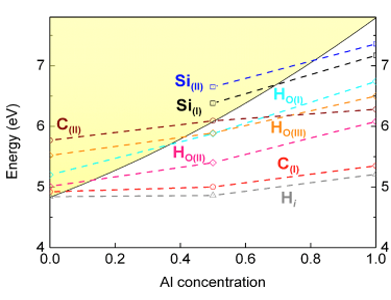
CMI researchers at Lawrence Livermore National Laboratory conducted the research for this highlight
Achievement
- Incorporated carbon and hydrogen impurities in metal organic vapor deposition methods used to grow high quality epitaxial films of ultrawide band gap semiconductor Ga2O3 and wider-band gap (Al,Ga)2O3 alloys.
- Identified that incorporating these impurities can complicate the realization of highly n-type material for certain growth conditions and Al contents.
Significance and Impact
- Confirmed that Si donors act as effective shallow donors for Al contents <70%.
- Revealed that C and H dopants can act as soluble compensators in even modest Al-content (Al,Ga)2O3 alloys.
- Identified composition regimes and process conditions that will be problematic for achieving highly conductive (Al,Ga)2O3 alloys.
Hub Goal Addressed
- Increase the speed of discovery and integration.
- Develop predictive models for real materials.
S. Mu, M. Wang, J. B. Varley, J. L. Lyons, D. Wickramaratne, C. G. Van de Walle, Role of carbon and hydrogen in limiting n-type doping of monoclinic (AlxGa1−x)2O3. Phys Rev B. 105, 155201 (2022).
